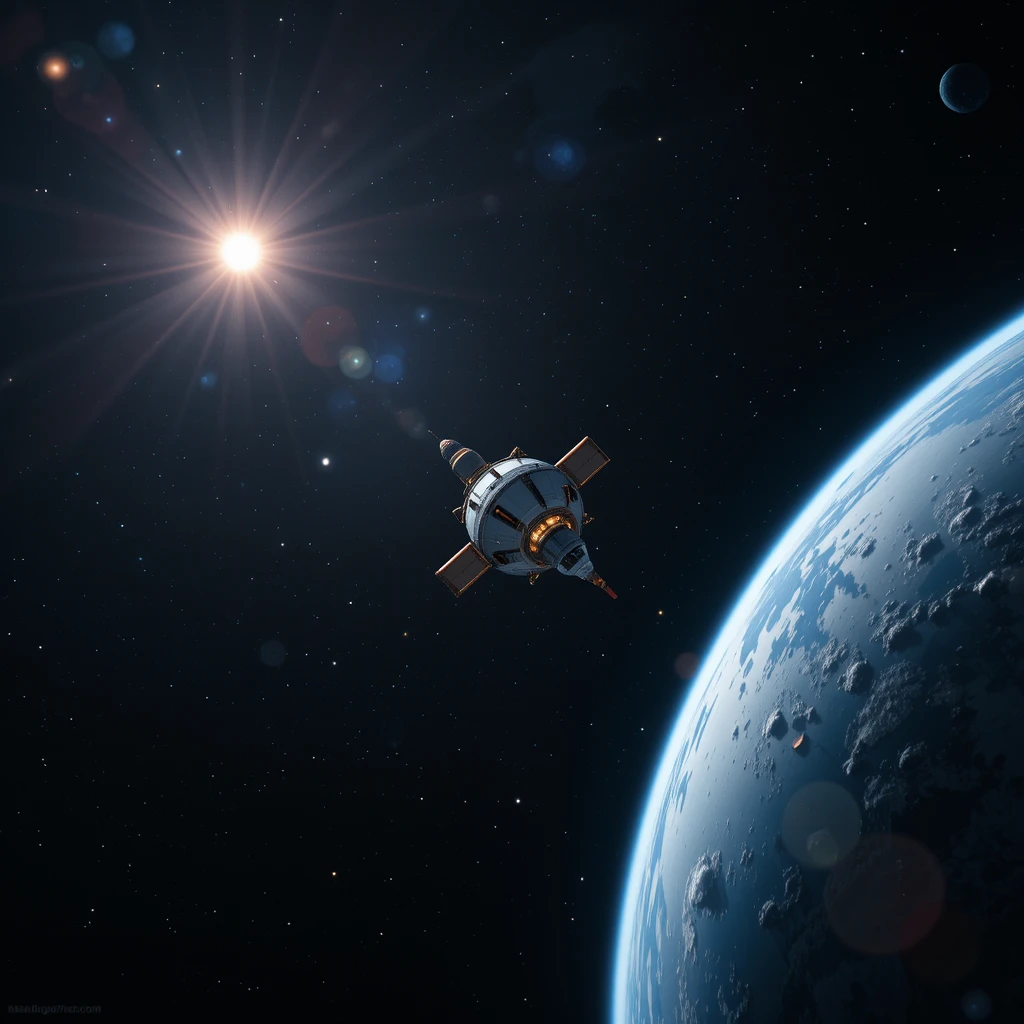Introduction
Mission Apollo 13, NASA’s third planned lunar landing mission, launched on April 11, 1970, with the goal of landing on the moon’s Fra Mauro highlands. Commanded by James A. Lovell Jr., with Jack Swigert as Command Module Pilot and Fred Haise as Lunar Module Pilot, the mission aimed to build on the successes of Apollo 11 and 12. However, an oxygen tank explosion two days into the journey transformed Apollo 13 from a lunar expedition into a desperate struggle for survival. This article provides a detailed account of the mission, the crisis that unfolded, and the remarkable efforts that brought the crew safely back to Earth.

Table of Contents
Background and Mission Objectives
The Apollo program, initiated in 1961, was the United States’ response to the Soviet Union’s early lead in the space race. By 1970, NASA had achieved the historic first moon landing with Apollo 11 and a second successful landing with Apollo 12. Apollo 13 was designed to further scientific exploration by targeting the Fra Mauro formation, a rugged lunar region believed to hold clues about the moon’s geological history.
The mission’s crew consisted of:
- James A. Lovell Jr. (Commander): A veteran astronaut with three prior spaceflights, including Apollo 8, the first human mission to orbit the moon.
- Jack Swigert (Command Module Pilot): A last-minute replacement for Ken Mattingly, who was grounded due to exposure to German measles.
- Fred Haise (Lunar Module Pilot): A first-time space traveler tasked with operating the lunar module and conducting moonwalks.

The spacecraft comprised the Command Module (Odyssey), which housed the crew during most of the journey, and the Lunar Module (Aquarius), intended for the moon landing. The Service Module provided propulsion, power, and life support systems.
Apollo 13’s objectives included:
- Landing in the Fra Mauro highlands to collect geological samples.
- Deploying scientific instruments, such as the Apollo Lunar Surface Experiments Package (ALSEP).
- Conducting experiments in lunar orbit and deep space.
The mission launched at 2:13 p.m. EST from Kennedy Space Center, Florida, aboard a Saturn V rocket. Despite a minor glitch during launch—when one of the second-stage engines shut down prematurely—the spacecraft entered Earth orbit and began its translunar trajectory.
The Crisis: “Houston, We’ve Had a Problem”
For the first 55 hours, Apollo 13 proceeded smoothly. The crew conducted routine tasks, including a televised broadcast showcasing life aboard the spacecraft. However, at 55 hours and 55 minutes into the mission, on April 13, 1970, a catastrophic event changed everything.
Mission Control in Houston requested the crew to stir the oxygen tanks in the Service Module, a standard procedure to ensure accurate readings. Moments after Swigert activated the stir, a loud bang reverberated through the spacecraft. Alarms blared, and the crew noticed a sudden drop in oxygen pressure and electrical power. Swigert calmly reported to Mission Control: “Houston, we’ve had a problem here.” Lovell, observing the situation, confirmed a gas venting into space from the Service Module.

The cause was later traced to Oxygen Tank No. 2, which had been damaged during ground testing years earlier. A fault in its wiring ignited the tank’s insulation during the stir, causing an explosion that ruptured the tank and damaged a second oxygen tank. The Service Module’s oxygen supply—critical for breathing, power generation, and propulsion—was rapidly depleting.
The immediate consequences were dire:
- Loss of Oxygen: The Command Module’s oxygen reserves began venting into space.
- Power Failure: The explosion damaged the fuel cells, which generated electricity by combining oxygen and hydrogen, leaving the Command Module reliant on limited battery power.
- Mission Abort: The lunar landing was no longer feasible; the priority shifted to returning the crew safely to Earth.
The Response: A Race Against Time
The explosion forced NASA to devise an unprecedented rescue plan. The Mission Control team, led by Flight Director Gene Kranz, worked around the clock with engineers, scientists, and backup crews to address the crisis. The crew’s survival depended on quick thinking, resourcefulness, and collaboration between the astronauts and ground teams.
Key Challenges and Solutions
- Power Conservation:
- The Command Module’s batteries were insufficient for the return journey, and its systems were shutting down. To conserve power, the crew powered down non-essential systems in Odyssey, reducing its functionality to a lifeboat.
- The Lunar Module, Aquarius, became the crew’s refuge. Designed to support two astronauts for 45 hours on the lunar surface, it now had to sustain three men for over 90 hours. The crew transferred to Aquarius, using its oxygen, power, and navigation systems.
- Trajectory Correction:
- The explosion occurred before Apollo 13 entered lunar orbit, so the crew was on a “free-return trajectory” that would naturally loop around the moon and return to Earth. However, the trajectory needed adjustment to ensure a safe reentry angle.
- Using Aquarius’s descent engine, the crew performed a critical burn shortly after the explosion to refine their path. A second burn after looping around the moon further adjusted their trajectory, reducing the return time.
- Carbon Dioxide Buildup:
- Aquarius’s life support system was not designed for three people over an extended period. Carbon dioxide levels began rising, threatening the crew with poisoning.
- The Lunar Module’s lithium hydroxide canisters, which scrubbed CO2 from the air, were depleting. The Command Module had spare canisters, but they were incompatible with Aquarius’s system (square canisters versus round slots).
- Engineers at Mission Control devised an ingenious solution using plastic bags, cardboard, tape, and a sock to adapt the Command Module’s canisters for use in Aquarius. The crew followed detailed instructions to construct this “mailbox” device, successfully reducing CO2 levels.
- Navigation and Reentry:
- With the Command Module powered down, the crew relied on Aquarius’s navigation system, which was not designed for deep-space operations. Lovell manually aligned the spacecraft using Earth as a reference point through the window.
- For reentry, the crew needed to reactivate Odyssey, which had been exposed to cold and condensation for days. The ground team developed a new power-up procedure, carefully sequencing systems to avoid short circuits.
- Water and Food Shortages:
- Water was rationed to prevent dehydration, as the spacecraft’s systems could no longer generate it. The crew consumed minimal food, leading to weight loss and fatigue.
- Despite these hardships, the crew maintained focus, trusting Mission Control’s guidance.
The Role of Mission Control
The ground team’s efforts were monumental. Flight controllers worked in shifts, simulating scenarios in training facilities and consulting with contractors who built the spacecraft’s components. Key figures included:
- Gene Kranz (Flight Director): His leadership and mantra, “Failure is not an option,” galvanized the team.
- Glynn Lunney, Milt Windler, and Gerry Griffin (Flight Directors): Each managed critical phases of the rescue.
- John Aaron (Electrical Systems Expert): He devised the power-up sequence for the Command Module.
- Ken Mattingly (Backup Command Module Pilot): Grounded but instrumental in simulator tests to troubleshoot reentry procedures.
The team’s ability to anticipate problems, test solutions, and relay clear instructions to the crew was pivotal. Their collaboration exemplified NASA’s problem-solving culture.
The Journey Home
On April 14, Apollo 13 looped around the far side of the moon, passing within 158 miles of its surface. The crew captured images of the lunar landscape, but the mission’s scientific goals were abandoned. The focus remained on survival.
As the spacecraft approached Earth, the crew faced additional challenges:
- Cold and Fatigue: Aquarius’s interior grew cold and damp, with temperatures dropping to near-freezing. The crew, sleep-deprived and undernourished, persevered.
- Reentry Risks: The Command Module’s heat shield, critical for surviving atmospheric reentry, might have been damaged in the explosion. There was also concern about the Service Module’s debris interfering with reentry.
On April 17, the crew jettisoned the damaged Service Module, photographing its exposed interior for later analysis. They then transferred back to Odyssey, powering it up using the new procedures. Finally, they jettisoned Aquarius, which had served as their lifeboat, watching it burn up in Earth’s atmosphere.
Splashdown and Aftermath
On April 17, 1970, at 1:07 p.m. EST, Apollo 13’s Command Module reentered Earth’s atmosphere. During reentry, a communications blackout lasting longer than expected—due to ionized gases around the spacecraft—caused tense moments in Mission Control. When Odyssey’s parachutes deployed and the capsule splashed down safely in the South Pacific near Samoa, cheers erupted in Houston and around the world.
The crew was recovered by the USS Iwo Jima, physically weakened but alive. Their ordeal, lasting 142 hours and 54 minutes, captivated global audiences, with millions following the drama via television and radio.
Investigation and Findings
A post-mission investigation revealed the root cause of the explosion:
- Oxygen Tank No. 2, originally installed in Apollo 10’s Service Module, was damaged during a ground test when it was dropped two inches, cracking its drain tube.
- The tank was later installed in Apollo 13. During pre-launch testing, a faulty heater failed to boil off liquid oxygen, and technicians used higher-than-normal voltage to compensate, damaging the tank’s insulation.
- The damaged wiring sparked during the stir, igniting the tank’s contents and causing the explosion.
NASA implemented several changes for future missions:
- Redesigning oxygen tanks to eliminate ignition risks.
- Adding a third oxygen tank and backup battery in the Service Module.
- Improving testing and quality control procedures.
Legacy and Impact
Apollo 13, though a “successful failure,” demonstrated the resilience of NASA’s teams and the power of human ingenuity. The mission’s lessons influenced subsequent Apollo flights, the Space Shuttle program, and modern space exploration.
Cultural Impact
- Public Awareness: The mission highlighted the risks of space exploration and NASA’s ability to overcome them, boosting public support for the agency.
- Media and Film: The 1995 film Apollo 13, directed by Ron Howard and starring Tom Hanks, brought the mission to new generations. Based on Lovell’s book Lost Moon, it dramatized the events with high accuracy, though some details were simplified.
- Phrases in Pop Culture: “Houston, we have a problem” (slightly misquoted from the original) and “Failure is not an option” became iconic expressions.
Scientific and Engineering Contributions
While Apollo 13 failed to achieve its scientific objectives, it yielded valuable data on spacecraft design and emergency procedures. The mission’s improvisations, such as the CO2 scrubber adaptation, are studied in engineering and crisis management courses.
Crew’s Post-Mission Lives
- Lovell retired from NASA in 1973 and pursued a business career, later co-authoring Lost Moon.
- Swigert left NASA in 1977, entered politics, and was elected to Congress but died of cancer in 1982 before taking office.
- Haise remained with NASA, working on the Space Shuttle program, and retired in 1979.
Conclusion
Apollo 13 stands as a testament to human courage, teamwork, and problem-solving under extreme pressure. What began as a routine lunar mission became one of NASA’s finest hours, showcasing the agency’s ability to turn a near-disaster into a triumph. The mission’s legacy endures in the lessons it taught, the inspiration it provided, and the reminder that even in the face of overwhelming odds, human determination can prevail.
As Gene Kranz later reflected, “Apollo 13 was a failure in its initial mission, but a triumph in its recovery.” The safe return of Lovell, Swigert, and Haise remains one of the most remarkable achievements in the history of space exploration.




